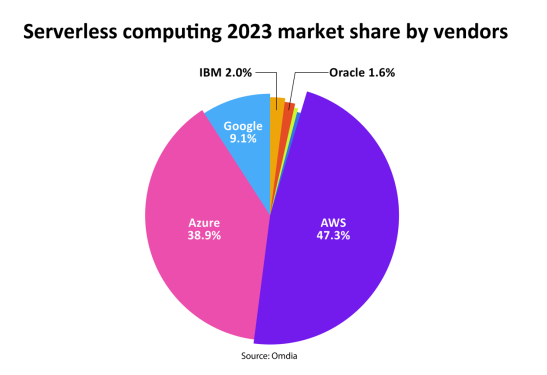
Omdia: serverless computing, valued at $19bn is the fastest-growing cloud service
LONDON, June 28, 2024: New analysis from Omdia’s Cloud Software & Services Intelligence Service shows that serverless computing has now reached $19bn with public cloud hyperscalers taking the largest share of this market.
The dominant vendor is Amazon AWS taking 47.3% of market share followed by Microsoft Azure at 38.9%. Omdia forecasts this market to grow to $41bn by 2028 with a CAGR of 16.5%. Following a slight dip in growth rate 2021-2023, Omdia predicts the growth rate will resume and increase between 2024-2028, and that AI workloads will play a significant role in increasing cloud revenues.

Omdia’s Serverless Computing Tracker 2024 shows that the serverless market splits into three distinct categories of services: compute & DevOps tools, serverless storage, and application/service integration. Omdia found that serverless computing has been used by at least a third of all cloud developers and this is increasing. Some startup businesses lacking data centers expertise prefer to go fully serverless from the beginning, eliminating the need to recruit IT staff and construct on-premises facilities.
“The serverless market started as a simple Function-as-a-Service where the developer sends some code to the serverless service which runs the code on a pay-as-you-go basis, typically rounded to the nearest millisecond,” explained Michael Azoff, Chief Analyst in Omdia’s Cloud and Data Center research practice. “The host provider operates a large multi-tenant compute architecture where the workloads are run fully administered and hidden from the user. This has quickly grown to include a wide range of services. Now, workloads can be executed in containers, and a variety of developer and DevOps tools are available under what we label ‘Compute and DevOps tools.”
Enterprise applications typically require stateful services, and data-intensive workloads necessitate robust storage capabilities. This has led to the introduction of serverless storage, the second serverless category in Omdia’s analysis. Additionally, developers aim to manage application workflows and achieve seamless serverless integration, which is addressed by Omdia’s third serverless category alongside integration tools.
“With serverless now widely adopted and generating significant revenue for public cloud hyperscalers, the plethora of serverless services can make it challenging for newcomers to identify the best starting points and navigate the various options. Our upcoming Serverless Tracker Analysis report will offer enterprises the necessary guidelines for success,” concludes Azoff.


